Bishop Raul Leads Laguna Pilgrimage for Lent
 Last April 2, Christ the King Parish’s Bishop Raul Martirez led a Laguna Pilgrimage. The pilgrimage, with 44 passengers in one tour bus, was organized by Catholic Travel, Inc. A total of seven Laguna churches were visited in just one day. These included, in sequence:
Last April 2, Christ the King Parish’s Bishop Raul Martirez led a Laguna Pilgrimage. The pilgrimage, with 44 passengers in one tour bus, was organized by Catholic Travel, Inc. A total of seven Laguna churches were visited in just one day. These included, in sequence:
• Diocesan Shrine of San Antonio de Padua, Pila
• Our Lady of Guadalupe, Pagsanjan
• St James the Apostle, Paete
• St Peter of Alcantara, Pakil
• Sta. Maria Magdalena, Magdalena
• St John the Baptist, Liliw
• San Bartolome Apostol, Nagcarlan
The majority of pilgrims were from villages of Christ the King parish – White Plains, Acropolis, Greenmeadows, Corinthian Garden, Corinthian Hills, and St. Ignatius. There was also a smattering of pilgrims from other places like Valle Verde & Ayala Alabang.
The pilgrim group left CTK at 6 am, visited the first three churches, stopped for lunch at Villa Socorro Farm in Pagsanjan, then completed the rest of churches in the list. Catholic Travel provided a guide who gave the history of the towns and the churches plus an escort who looked after the pilgrims’ needs and the tour logistics. For each of the churches visited, Bishop Raul narrated the biography of the patron saint of the church.
 The Shrine of San Antonio de Padua in Pila, Laguna was the first Antonine church in the country, and the first church to be dedicated to St. Anthony of Padua in all of Asia. Construction started in 1581 on the 350th anniversary of the saint’s death, with the church and rectory being completed in 1617. The Franciscans set up the country’s second printing press in Pila in 1606, printed the first Tagalog dictionary in 1613, and ran the Franciscan Order’s infirmary in Pila. The parish seal depicts St. Anthony holding a lily, symbol of
The Shrine of San Antonio de Padua in Pila, Laguna was the first Antonine church in the country, and the first church to be dedicated to St. Anthony of Padua in all of Asia. Construction started in 1581 on the 350th anniversary of the saint’s death, with the church and rectory being completed in 1617. The Franciscans set up the country’s second printing press in Pila in 1606, printed the first Tagalog dictionary in 1613, and ran the Franciscan Order’s infirmary in Pila. The parish seal depicts St. Anthony holding a lily, symbol of
purity, in his right hand and carrying the Child Jesus on his left arm. Known as the ‘miracle worker’ even during his lifetime, St. Anthony is the most venerated Franciscan saint next to the founder of the order himself, St. Francis of Assisi. An interesting side story was of the towns people submerging the Pila church bell, cast in 1681, in Laguna de Bay during the British invasion of 1762 to avoid it being taken as war spoils.
 The church has a three-level facade with classical Doric columns. At the pediment is a niche reserved for St. Anthony. Windows of the choir loft can be seen at the second level while niches for the statues of the Sacred Heart of Jesus and the Immaculate Heart of Mary are found at the lowest level. The semicircular arched doorway has the Franciscan seal on top. On the right side of the church is the convent, now used as a school building, while a square based octagonal bell tower is on the left side.
The church has a three-level facade with classical Doric columns. At the pediment is a niche reserved for St. Anthony. Windows of the choir loft can be seen at the second level while niches for the statues of the Sacred Heart of Jesus and the Immaculate Heart of Mary are found at the lowest level. The semicircular arched doorway has the Franciscan seal on top. On the right side of the church is the convent, now used as a school building, while a square based octagonal bell tower is on the left side.
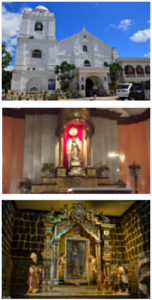 Our Lady of Guadalupe Parish Church in Pagsanjan is the oldest church in the Philippines under the patronship of Our Lady of Guadalupe, whose life-size image of the Lady was contributed by Mexican Catholics in 1958, to replace the original image from 1688 which was heavily damaged by American and Filipino military bombers during WW2. The 1688 image was also donated by rich and pious Mexican families. Serious restoration took place in 1965 and in 1969, the main altar was consecrated, with the image of Our Lady of Guadalupe carved by Maximo Vicente of Manila.
Our Lady of Guadalupe Parish Church in Pagsanjan is the oldest church in the Philippines under the patronship of Our Lady of Guadalupe, whose life-size image of the Lady was contributed by Mexican Catholics in 1958, to replace the original image from 1688 which was heavily damaged by American and Filipino military bombers during WW2. The 1688 image was also donated by rich and pious Mexican families. Serious restoration took place in 1965 and in 1969, the main altar was consecrated, with the image of Our Lady of Guadalupe carved by Maximo Vicente of Manila.
The facade is a three-level early Renaissance styled with a semicircular arched main entrance, choir loft window and a three-story bell tower. A side chapel houses a replica of the tilma, or cloak, of the Our Lady of Guadalupe, and a stone relic from Tepeyac Hill, Mexico City in 1531, the site of the apparition of the Virgin of Guadalupe.
St. James the Apostle Church in Paete has a long history of being destroyed then rebuilt due mostly to earthquakes – first in 1717, then in 1880, and the last earthquake was in 1937. The church also served as a dungeon and torture house for the people of Paete during the Japanese occupation of the Philippines in WW2.
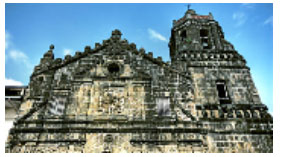 The church is known for its huge and exquisite collection of images depicting the Passion of Christ, it’s centuries-old paintings, intricate retable pieces, and wooden images of saints, all handcarved and painted by Paetenian locals that showcase their mastery and skills in woodcarving. Unfortunately, some of the earlier masterpieces had been dest royed along with the earlier versions of the church. The current baroque style of the church has large buttresses on each side made of adobe bricks and other native materials. One interesting trivia is that the Paete parish is officially linked, since February 2016, to the Cathedral of Santiago de Compostela in Spain by virtue of the Declaration of Spiritual Bond of Affinity. The Compostela cathedral gifted the Paete parish with ‘a stone relic from the tomb of St. James the Great and a silver medallion that reverently touched the remains of the apostle’.
The church is known for its huge and exquisite collection of images depicting the Passion of Christ, it’s centuries-old paintings, intricate retable pieces, and wooden images of saints, all handcarved and painted by Paetenian locals that showcase their mastery and skills in woodcarving. Unfortunately, some of the earlier masterpieces had been dest royed along with the earlier versions of the church. The current baroque style of the church has large buttresses on each side made of adobe bricks and other native materials. One interesting trivia is that the Paete parish is officially linked, since February 2016, to the Cathedral of Santiago de Compostela in Spain by virtue of the Declaration of Spiritual Bond of Affinity. The Compostela cathedral gifted the Paete parish with ‘a stone relic from the tomb of St. James the Great and a silver medallion that reverently touched the remains of the apostle’.
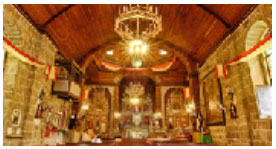 The current baroque mission church has large buttresses on each side to improve its earthquake resistance. It was made of adobe bricks, a mixture of egg white and other native materials. The church has an elaborate baroque style with a fusion of oriental artistry. The intricate retablo pieces were made by Paetenian natives. The church’s facade is divided by a frieze that continues around the adjoining belltower. It has bas reliefs of leaves and flowers and a sculpted image of St. James depicted as a Saint James the Moor – slayer in a central niche of the upper story. The large murals of St. Cristopher on wood panels inside the church were executed by another notable son of Paete, Luciano Dans.
The current baroque mission church has large buttresses on each side to improve its earthquake resistance. It was made of adobe bricks, a mixture of egg white and other native materials. The church has an elaborate baroque style with a fusion of oriental artistry. The intricate retablo pieces were made by Paetenian natives. The church’s facade is divided by a frieze that continues around the adjoining belltower. It has bas reliefs of leaves and flowers and a sculpted image of St. James depicted as a Saint James the Moor – slayer in a central niche of the upper story. The large murals of St. Cristopher on wood panels inside the church were executed by another notable son of Paete, Luciano Dans.
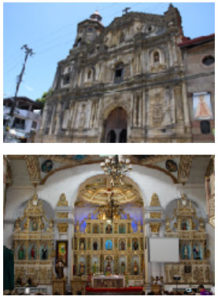 St. Peter of Alcantara Church in Pakil, designated as the Diocesan Shrine of Nuestra Señora de los Dolores de Turumba, was finished in 1767 after 35 years of construction and is widely known as the home of the Nuestra Señora de los Dolores, or the ‘Virgen de Turumba’ which was enshrined in the church in 1788. The icon of Our Lady is a 9 by 11 inches oil painting on canvas. The face of Mary is contorted by pain from the dagger plunged into her heart. The image of the Virgin Mary as Our Lady of Sorrows is a replica of the image of Nuestra Señora de las Antiguas from Spain. The image, according to tradition, belonged to some missionaries who crossed Laguna de Bay in a launch. When the launch was shipwrecked, some of its relics were washed ashore including the icon of the Virgin. One Friday morning, some fishermen found the icon in their nets. Believing it to be a religious image, they decided to bring it to a parish church. When the men carried the small painting, they found it too heavy. They tried sailing with it in many directions, until they brought it near the church of Pakil. When they headed that way, the wind and current aided their course, and upon landing, they left the heavy image on a rock so they could continue their fishing duties. A group of women found the icon the following Sunday morning. Although it had rained during the night, the canvas was dry. When they tried to take the icon away, they could not move it; even the strongest among them, Mariangga, could not lift it. They quickly told the parish priest, who in turn called the sacristans, choristers, and churchgoers at Mass to fetch the image. As they lifted the image, it gave way. This the people around begun to sing and dance; the turumba was born. By order of Pope Pius XII, and in recognition of the miracles credited to it, the Nuestra Señora de las Antiguas was episcoapally crowned by Alejandro Olalia, the Bishop of Lipa, on 23 May 1953.
St. Peter of Alcantara Church in Pakil, designated as the Diocesan Shrine of Nuestra Señora de los Dolores de Turumba, was finished in 1767 after 35 years of construction and is widely known as the home of the Nuestra Señora de los Dolores, or the ‘Virgen de Turumba’ which was enshrined in the church in 1788. The icon of Our Lady is a 9 by 11 inches oil painting on canvas. The face of Mary is contorted by pain from the dagger plunged into her heart. The image of the Virgin Mary as Our Lady of Sorrows is a replica of the image of Nuestra Señora de las Antiguas from Spain. The image, according to tradition, belonged to some missionaries who crossed Laguna de Bay in a launch. When the launch was shipwrecked, some of its relics were washed ashore including the icon of the Virgin. One Friday morning, some fishermen found the icon in their nets. Believing it to be a religious image, they decided to bring it to a parish church. When the men carried the small painting, they found it too heavy. They tried sailing with it in many directions, until they brought it near the church of Pakil. When they headed that way, the wind and current aided their course, and upon landing, they left the heavy image on a rock so they could continue their fishing duties. A group of women found the icon the following Sunday morning. Although it had rained during the night, the canvas was dry. When they tried to take the icon away, they could not move it; even the strongest among them, Mariangga, could not lift it. They quickly told the parish priest, who in turn called the sacristans, choristers, and churchgoers at Mass to fetch the image. As they lifted the image, it gave way. This the people around begun to sing and dance; the turumba was born. By order of Pope Pius XII, and in recognition of the miracles credited to it, the Nuestra Señora de las Antiguas was episcoapally crowned by Alejandro Olalia, the Bishop of Lipa, on 23 May 1953.
 The word ‘turumba’ is from a Filipino phrase which translates to ‘tremble in great joy’ and is also understood to represent the sound of drumbeats during a procession. The Zirst Turumba feast in the Lady’s honor was held in September 15, 1788. The annual Seven Days of Sorrows known as Lupi or Turumba fiestas is reputed to be the longest festival in the country, starting from before Palm Sunday (first Lupi) all the way to Pentecost Sunday (7th Lupi). Then on September 15, the town celebrates the discovery of the image and the image is taken on a procession on October 19, the town fiesta day.
The word ‘turumba’ is from a Filipino phrase which translates to ‘tremble in great joy’ and is also understood to represent the sound of drumbeats during a procession. The Zirst Turumba feast in the Lady’s honor was held in September 15, 1788. The annual Seven Days of Sorrows known as Lupi or Turumba fiestas is reputed to be the longest festival in the country, starting from before Palm Sunday (first Lupi) all the way to Pentecost Sunday (7th Lupi). Then on September 15, the town celebrates the discovery of the image and the image is taken on a procession on October 19, the town fiesta day.
The church of Pakil has survived many disasters over the centuries, including a great fire in 1851 that destroyed much of the town, earthquakes in 1881 and 1937, and bombings and shell explosions during WW2. After each event where the image of the Blessed Virgin survived intact, devotion to her increased tremendously. The church’s facade is adorned with shields, crosses and angels. Inside, 14 icons are depicted in the main altar with each icon enclosed in an intricately-carved niche with the Archangel Michael towering above. An original painting by 19th century Paete painter Jose Dans, entitled ‘Judicum Finale’ depicts heaven, purgatory and hell.
 The Santa Maria Magdalena parish church in Magdalena town, first made of cogon and wood and constructed in 1820 was dedicated to Mary Magdalene.
The Santa Maria Magdalena parish church in Magdalena town, first made of cogon and wood and constructed in 1820 was dedicated to Mary Magdalene.
The sandstone church that now stands was initiated in 1829, with townspeople forced to pay taxes and quarry sand and stones from the river. It was finished in 1855 with the bell tower added in 1861. It is said that Philippine revolutionary hero Emilio Jacinto sought refuge in the church’s convent in 1898 where his bloodstains were found on its floor after being wounded in a battle with the Spaniards at the Maimpis River.
 St. John the Baptist Parish Church in the town of Liliw has a beautiful baroque façade adorned with red bricks which was partially destroyed by the 1880 earthquake. It was reconstructed in 1885 but was partially burned in 1898. It also contains stained glass images along with red bricked columns and 3 retablos finished in gold leaf. The retablo mayor has 13 niches across four levels housing statues of saints. From the church’s ntresuelo entrance, a small passageway to the left leads to a small chapel with the image of San Buenaventura enclosed in a retablo. In 1664, the image of San Buenaventura wept and sweated blood, witnessed by Padre Juan Pastor and 120 other Lilit townsfolk. The grounds outside the church was designed to promote Christian teachings for pilgrims. At the middle of the patio fronting the church is a white statue of the Sacred Heart of Jesus. It is flanked on both sides by several white statues of different saints. The church patio was named Patio de Sagrada Familia.
St. John the Baptist Parish Church in the town of Liliw has a beautiful baroque façade adorned with red bricks which was partially destroyed by the 1880 earthquake. It was reconstructed in 1885 but was partially burned in 1898. It also contains stained glass images along with red bricked columns and 3 retablos finished in gold leaf. The retablo mayor has 13 niches across four levels housing statues of saints. From the church’s ntresuelo entrance, a small passageway to the left leads to a small chapel with the image of San Buenaventura enclosed in a retablo. In 1664, the image of San Buenaventura wept and sweated blood, witnessed by Padre Juan Pastor and 120 other Lilit townsfolk. The grounds outside the church was designed to promote Christian teachings for pilgrims. At the middle of the patio fronting the church is a white statue of the Sacred Heart of Jesus. It is flanked on both sides by several white statues of different saints. The church patio was named Patio de Sagrada Familia.
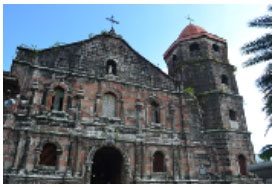 Built in 1752, San Bartolome Apostol Parish Church in Nagcarlan was made of multicolored stones and bricks that were donated by the townspeople during construction. In 1781, the church was partly destroyed by fire so it underwent reconst ruct ion which gave the authorities a chance to add a four storey brick bell tower, a choir loft on three strong arches, an underground cemetery, and elaborately designed tiles. The current design is mostly baroque, and the design of the facade has a semicircular arched main entrance along with semicircular windows and tall pedestals and columns at the side entrance. The bell tower carries the Franciscan coat of arms and Musliminspired crenelations.
Built in 1752, San Bartolome Apostol Parish Church in Nagcarlan was made of multicolored stones and bricks that were donated by the townspeople during construction. In 1781, the church was partly destroyed by fire so it underwent reconst ruct ion which gave the authorities a chance to add a four storey brick bell tower, a choir loft on three strong arches, an underground cemetery, and elaborately designed tiles. The current design is mostly baroque, and the design of the facade has a semicircular arched main entrance along with semicircular windows and tall pedestals and columns at the side entrance. The bell tower carries the Franciscan coat of arms and Musliminspired crenelations.
There were quite a number of signees who did not make the cut-off. As a result, a second pilgrimage was quickly organized for the following Sunday, April 9. This second pilgrimage had 22 attendees in a smaller van plus a family in a private car.
We asked Bishop Raul Martirez how the Laguna pilgrimage was first conceived. He answered that Mrs. Jane Dee of of Acropolis and her friends requested him to lead them on a Lenten pilgrimage. Bishop Raul remembered having visited the Laguna churches some years back with the Christian Family Movement, or CFM, so he advised Mrs. Dee’s group to contact Catholic Travel.
When asked if he had any future plans for similar local pilgrimages, Bishop Raul said he was thinking of going north next year.
Catholic Travel was set up in 1961 by Rufino Cardinal Santos to service the travel requirements of the Catholic Church in the country. It’s the Ministry of Pilgrimages of the Roman Catholic Archdiocese of Manila and assists the Church, her members, ministries and institutions in its evangelical mission of promoting the Kingdom of God by customizing pilgrimages and offering travel services. Fr. David Concepcion is the current president of the company.
